Within the veterinary industry, several common hazards can occur in the workplace. You need to know and understand these hazards and how to control them so workers are not exposed to the risks of these potential hazards.
Awareness of workplace hazards and risks is an important element for any employee. Often, the more obvious areas of concern will have already been identified by management and/or industry advisory bodies, which will be documented in your Workplace Health and Safety policy. However, it is the responsibility of individual employees to be familiar with each identified hazard and the likelihood of it occurring (risk factor) and report any unsafe practices, broken machinery/equipment or poor layout of furniture/equipment. This helps to prevent near misses or injuries from occurring.
What is the difference between Hazards and Risks?
A Hazard can cause you harm, such as electricity, chemicals, or an animal.
A Risk is the likelihood of that hazard occurring and also the level of severity of harm that it may cause.
Effective risk management involves four steps that must be documented within policies and procedures and followed by all personnel.
- Identify Hazards - Find out what could cause harm. These may be hazards caused by animals, chemicals, biological elements, and/or radiation.
- Assess Risks - Understand the likelihood of a hazard causing harm and how serious it could be.
- Control Risks - Implement the most effective control measure reasonably practicable.
- Review Control Measures - Set up a regular review schedule to ensure the most effective control measure is being used and that it is working as planned.
Watch
Watch this short animation from Safeti.UK that explains the difference between safety and hazard.
Case Study
Background
Happy Paws Animal Shelter is committed to providing a safe environment for animals and staff. Despite rigorous protocols, the dynamic nature of animal care presents various risks and hazards. This case study examines several incidents to highlight the potential dangers and the measures taken to mitigate them.
Incident 1: Dog Bite
Date: April 20, 2023
Description: During the morning shift, John, an animal attendant, attempted to move Max, a recently rescued stray dog, to a different enclosure for a health check. Max, feeling stressed and scared, bit John's hand.
Risk/Hazard: Animal bites can cause severe injury and infection, posing a significant risk to staff.
Response and Actions:
- Immediate First Aid: John applied pressure to stop the bleeding, washed the wound with soap and water, and applied an antiseptic.
- Medical Attention: John was sent to a healthcare facility for further treatment and a tetanus shot.
- Incident Report: The incident was documented, and a report was filed according to the facility’s protocol.
- Behaviour Assessment: Max underwent a thorough behavioural assessment by the veterinarian to identify triggers and develop a management plan.
- Training Review: Staff received refresher training on safely handling stressed and aggressive animals.
- Outcome: John recovered fully after medical treatment. Max’s behavioural plan helped reduce his stress and prevent future incidents.
- Control Measures: Wear appropriate PPe, use correct handling methods and restraint, observe and read animals body language, ask for help, take it slow and build trust with the animal, provide treats if allowed
Incident 2: Chemical Exposure
Date: April 22, 2023
Description: During the sanitation process, Emma, another animal attendant, accidentally mixed two cleaning agents, causing a chemical reaction that released harmful fumes.
Risk/Hazard: Exposure to toxic fumes from improperly mixed chemicals can cause respiratory and other health problems.
Response and Actions:
- Immediate Evacuation: Emma and nearby staff were evacuated to prevent further exposure.
- Ventilation: The area was ventilated to disperse the fumes.
- Medical Evaluation: Emma was evaluated by a medical professional for any respiratory issues.
- Review of Safety Protocols: The incident prompted a review and reinforcement of safety protocols regarding using and mixing chemicals.
- Safety Training: All staff received additional training on chemical safety, proper labelling, and the importance of following manufacturer instructions.
- Outcome: No long-term health effects were reported. Enhanced safety measures were implemented to prevent future incidents.
- Control Measures: Wear appropriate PPE, follow safety data sheets, do not handle chemicals if you have not been trained to do so
Incident 3: Slips, Trips, and Falls
Date: April 25, 2023
Description: Alice, an animal attendant, slipped on a wet floor in the common area after mopping, resulting in a minor sprain.
Risk/Hazard: Wet floors and cluttered walkways can lead to slips, trips, and falls, causing injuries.
Response and Actions:
- First Aid: Alice received immediate first aid and was advised to rest and apply ice to the injured area.
- Incident Investigation: The incident was investigated to determine the cause and identify preventive measures.
- Signage: Additional wet floor signs were placed in areas prone to spills and during cleaning times.
- Housekeeping Procedures: The facility reviewed and improved housekeeping procedures to ensure spills were promptly cleaned and areas properly marked.
- Footwear Policy: A reinforced policy on wearing appropriate, non-slip footwear was communicated to all staff.
- Outcome: Alice returned to work after a short recovery period. The new measures reduced the risk of future slips and falls.
- Control Measures: Display wet floor sign
Conclusion
This case study highlights the importance of recognizing and addressing various risks and hazards in an animal care facility. The incidents at Happy Paws Animal Shelter demonstrate the need for:
- Effective Training: Regular and comprehensive training on animal handling, chemical safety, and housekeeping.
- Immediate Response: Quick and appropriate responses to incidents to minimize harm.
- Preventive Measures: Continuous assessment and improvement of safety protocols to prevent future occurrences.
- Communication and Documentation: Clear communication and thorough documentation of incidents to facilitate learning and improvement.
By understanding and mitigating these risks, Happy Paws Animal Shelter ensures a safer environment for staff and animals.
Duty of care
Employers and Employees have legal responsibilities per Workplace Health and Safety legislation. Acts will often refer to the phrase "duty of care". This is the care owed by one person to another. Concerning hazards and risks in the workplace, a duty of care helps to ensure that hazards are identified, assessed, and controlled (hierarchy of control = elimination, substitution, engineering, administration, or personal protective equipment), and the process is reviewed regularly by applicable parties to reduce incidents.
Employer duty of care
An employer must do the following.
- Provide a safe working environment for employees.
- Provide safe systems of work and safety procedures.
- Machinery, plant, and equipment need to be maintained in a safe condition.
- Substances used in the workplace need to be stored and used according to the manufacturer's instructions.
- Provide information, instruction, supervision, and training to ensure each employee is safe from injury and risks to health.
Employee duty of care
An employee must do the following.
- Take reasonable care of their health and safety; for example, use personal protective equipment if provided.
- Take reasonable care for the health and safety of others.
- Comply with any reasonable instructions, policies, and procedures provided by the employer, business, or WHS representative.
- Report any unsafe practices or equipment.
Read the case study below regarding duty of care. This exemplifies how duty of care is implemented in a work-based environment.
Case Study

Background
Happy Paws Animal Shelter is a non-profit organization dedicated to rescuing, rehabilitating, and rehoming abandoned and stray animals. The facility houses approximately 50 dogs and 30 cats at any given time, with 10 animal attendants working in shifts to ensure round-the-clock care.
The Incident
On April 15, 2023, Jane, an animal attendant, was responsible for the morning shift. During her routine health checks, she noticed that Bella, a two-year-old Labrador, appeared lethargic and uninterested in her food. Bella had also vomited overnight, and her water bowl was untouched.
Recognising the signs of potential illness, Jane immediately reported Bella's condition to the senior veterinarian, Dr. Smith. Dr Smith conducted a thorough examination and diagnosed Bella with a gastrointestinal infection, which required immediate medical treatment and monitoring.
Response and Actions
1. Immediate Care
Isolation: Jane followed the facility's infection control protocol by isolating Bella in a separate enclosure to prevent the potential spread of infection to other animals.
Medication: Dr Smith prescribed antibiotics and anti-nausea medication, which Jane administered as per the veterinarian's instructions.
Hydration: Jane provided Bella with intravenous fluids to prevent dehydration.
2. Monitoring and Documentation
Observation: Jane regularly checked Bella every two hours, noting any changes in her condition and behaviour.
Record Keeping: Detailed records of Bella's symptoms, medication administration, and response to treatment were maintained to ensure accurate communication with the veterinary team and the next shift.
3. Communication
Team Briefing: Jane briefed the afternoon shift team on Bella's condition and the care plan, ensuring continuity of care.
Client Notification: Bella was an animal awaiting adoption, and her potential adopters were informed of her condition and the steps to ensure her recovery.
Outcome
Due to the prompt and appropriate care provided by Jane and the veterinary team, Bella's condition improved significantly over the next 48 hours. She responded well to the treatment, regained her appetite, and began to show signs of her usual playful behaviour. Bella made a full recovery and was later adopted by a loving family.
Key Learnings
- Importance of Vigilance and Prompt Action
- Jane's immediate recognition of Bella's symptoms and swift reporting to the veterinarian were crucial in preventing the condition from worsening.
- Adherence to Protocols
- Following established infection control and medication administration protocols ensured that Bella received the appropriate care without risking the health of other animals in the facility.
- Effective Communication
- Clear communication between staff members and potential adopters ensured everyone was informed and involved in Bella's care and recovery process.
- Documentation and Monitoring
- Detailed and accurate documentation of Bella's condition and treatment allowed effective monitoring and continuity of care across different shifts.
Conclusion
This case study highlights the essential duty of care responsibilities in an animal care facility. By being vigilant, adhering to protocols, and maintaining clear communication, animal attendants can ensure the health and well-being of the animals in their care. The successful recovery of Bella underscores the importance of these practices in providing high-quality animal care.
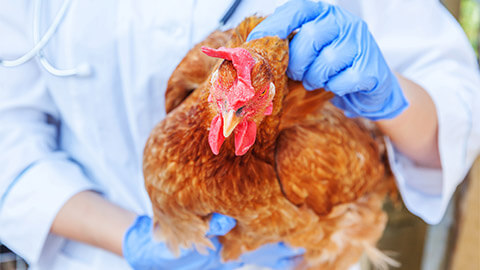
Animal handling presents a very likely risk of injury and must be undertaken with due caution and by following set procedures.
Always ensure you are adequately prepared before handling animals, close doors, remove obstacles and secure other animals. Observe the behaviour and temperament of the animal before approaching to ascertain if it is displaying signs of stress, fear or aggression. Use appropriate restraint techniques and equipment. Before and after handling animals it is best practice to practice effective personal hygiene (handwashing).
Common Injuries/Conditions
Common injuries/conditions (hazards) that can occur as a result of animal handling include:
- Bites - Most animals can bite, some worse than others.
- Scratches - Animals with sharp claws can inflict serious scratches on your skin if they are scared or trying to flee.
- Envenomation - Venomous snakes and certain other animals come with this additional risk. Immediate first aid and professional medical assistance are required if envenomation occurs. Control measures to prevent or minimise the risk: do not handle snakes if you are not trained to do so and do not have the correct tools/resources available
- Kicks, crush injuries, head butting/charging, and trampling are common when handling large animals such as livestock or horses.
- Zoonotic diseases - These are diseases that can be transmitted from animals to humans if proper precautions are not taken.
In addition to these injuries, it is important to consider exposure to some bodily fluids as they can also cause illness and potential infection if proper hygiene has not been carried out. Bodily fluids from animals may include:
- blood
- faeces
- vomit
- urine
- saliva
- placenta.
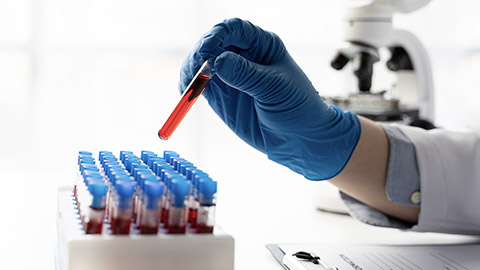
A zoonosis is an infectious disease caused by bacteria, viruses and parasites that spread between animals and humans.
Control Measures to prevent or minimise risk: Wear appropriate PPE hand hygiene before and after handling all animals
Types of Zoonotic Diseases
Visceral larval migrans (roundworm)
It occurs in dogs, cats and other animals when roundworm larvae migrate to and mature in tissue rather than the gastrointestinal tract. Causes tissue damage, allergic reactions, and visual and/or neurological damage. Prevented by deworming pets and maintaining hygiene.
Scabies
It mainly occurs in dogs, pigs and humans. Contracted via direct contact with an infected animal. Causes itchy red dots on the skin from burrowing mites. Prevented by maintaining hygiene and treating infected animals.
Hydatid tapeworm
Occurs in humans through contact with infected dog and cat faeces. Causes cysts to develop in the lungs, liver, and brain - these cysts can be 50cm in diameter. During surgical removal, cysts may burst and form hundreds of new cysts. Prevented by maintaining proper hygiene, wearing gloves, deworming animals for hydatid tapeworm and not feeding raw liver, lungs or other organs of sheep to animals.
Ringworm
Transmitted from cats, dogs, and horses, it is not a worm but a fungal infection of the top layers of the skin and hair. The kinds of fungi that cause ringworm are called Dermatophytes. While generally harmless, ringworms are highly contagious to humans, especially to children, the elderly, and anyone with a compromised immune system.
Toxoplasmosis
Toxoplasmosis is a disease caused by the parasite Toxoplasma gondii, which can be found in garden soil and raw meat. Cats can get toxoplasma infection by killing and eating infected prey. When pregnant women are exposed, the following foetal defects may occur; foetal retardation, anaemia, hydrocephalus (water on the brain) and miscarriage. Males and non-pregnant females may experience flu-like symptoms when infected. It is prevented by cleaning up cat faeces immediately while wearing gloves, as transmission through infected cat faeces is most common (ideally, pregnant women should avoid cleaning up cat faeces altogether), avoid handling raw or uncooked meat, peel and wash home-grown vegetables, wear gloves when gardening and cleaning up sandpits, maintain hygiene.
Salmonella
Salmonella is a large family of bacteria. Reptiles and other animals can carry a range of Salmonella in their intestines. When ingested by humans, this bacterium can potentially cause severe intestinal disease. Good personal hygiene measures, including effective and thorough hand washing and personal protective equipment such as disposable gloves, will help reduce the likelihood of infection.
Staphylococcus
Staphylococcus is caused by Staphylococcus bacteria. Generally, Staphylococcus bacteria can live on the skin of mice and other rodents in small numbers without causing any disease in healthy animals. However, when a mouse has a compromised immune system through an injury or an underlying illness, the Staphylococcus bacteria can grow in large numbers and cause pain and discomfort to the rodent through skin sores and general ill thrift. Human handlers must ensure quarantine procedures are used to avoid contracting the skin bacteria from infected rodents.
Q Fever
Q Fever is a disease that affects livestock (most commonly sheep, goats and cattle). Q Fever presents as flu-like symptoms, malaise, fever, cough and nausea in humans. Severe cases can result in hepatitis. A vaccination is available, and animal carers working with livestock are recommended to get vaccinated.
Hendra Virus
Hendra Virus is a virus that infects large fruit bats (flying foxes). Occasionally, the virus can spread from flying foxes to horses, and horses can then pass the infection on to humans. There is a vaccine available for this virus. Hendra Virus can be deadly to humans.
Watch
Watch the next couple of videos explaining Zoonotic Diseases in more detail.

Bites and scratches not only cause pain and discomfort, but there is also the risk of wound infection, contracting a zoonotic disease or, in the cases of severe injury, surgical intervention.
Animals are creatures of habit, if you are working in an animal care facility caring for an animal the chances are that you have disrupted their routine, causing anxiety and possibly fear-driven behaviour. Even the most placid animals may become frightened by strange people and different noises.
Injury
In the event of an injury, it is very important to follow these steps to avoid further injury to both the handler and the animal.
- Secure the animal (or get someone with the correct knowledge to assist if you cannot do this).
- Bathe the affected area with antiseptic (such as iodine).
- Apply basic first aid, such as dressings, to control bleeding.
- Notify your supervisor and complete a workplace incident report form.
- Seek medical advice for more serious injuries.
Bites
Australia has many venomous creatures on land and in the sea, however, snakes pose the more common hazard. If your job role is likely to encounter venomous snakes in captivity or the wild, you must be aware of the recommended first aid treatment for such an envenomation incident.
- Do NOT wash the bite area - Traces of venom can be used by medical professionals to identify the type of snake.
- Do NOT cut around the area or try to suck out the venom.
- Do NOT use a tourniquet - These can be fatal if applied incorrectly and are ineffective in this situation.
- Bandage firmly, splint and immobilise - Venom is spread through the lymphatic system, activated by movement. The spread can be reduced/slowed by applying a firm bandage over a folded pad placed on the bitten area. Remember: make sure that blood circulation is not cut off. Bandaging should still be applied even if the bite is to the trunk/torso area. Use a splint to immobilise the limb/patient further.
- Seek professional medical attention immediately, but try not to move the patient. They should not be walking themselves. Movement should be limited. Use a stretcher if need be.

In the animal care industry, you may encounter situations that cause psychological distress or damage. Some of these situations may include:
- overtime and working long hours
- shift work
- dealing with difficult and/or grieving clients
- animal suffering
- euthanasia of sick and sometimes healthy animals
- heavy workloads
- conflicts with colleagues
- workplace bullying/harassment.
The above factors may contribute to causing work-related stress. Work-related stress is a significant health and safety issue and may have temporary or lasting effects on your mental health and physical well-being. Depression, anxiety, a drop in productivity, headaches, difficulty sleeping, lethargy and an increase in sick days may all be signs of work-related stress. If you are experiencing any of the above symptoms, you are urged to seek assistance from your supervisor, human resources manager, doctor or psychologist.

Ergonomic hazards can occur as a result of:
- Incorrect lifting technique - Resulting in back strain. Ensure you use the correct lifting technique and seek assistance when lifting heavy items (including heavy animals).
- Incorrect sitting posture - Resulting in neck strain, eye strain, and headaches. Ensure you have your chair, desk and computer set up correctly for your height and desk layout.
- Repetitive actions - Result in Carpal Tunnel Syndrome (a disorder in the wrist and hand). Ensure you take regular breaks and wear appropriate protective gear.
Manual Handling
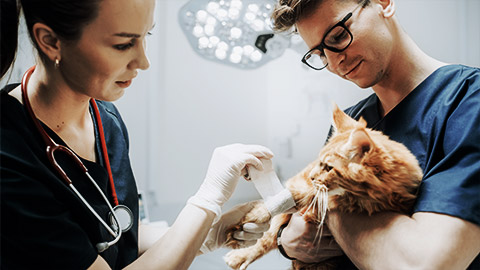
Manual handling is a part of every job; however, in a veterinary clinic, you may do more than others. Manual handling tasks could include:
- lifting animals
- replenishing stocks of tinned and dry food
- stacking boxes.
Your work tasks may sometimes involve bending, stretching, twisting, or working with heavy loads. These increase the risk of manual handling injuries if the functions are not performed correctly. Several injuries can be sustained if not living correctly; some of these may include:
- sprains to muscles, ligaments, and tendons
- back injuries with the inclusion of damage to nerves, discs and tendons
- Joint and bone injuries include shoulder, wrist, knees, ankles, elbows, hands and feet
- Control measures to prevent or minimise the risk include using the correct lifting technique, using trolleys or manual aids, ask for assistance.
Correct lifting techniques
Ensure you keep your back straight at all times, unlike the following diagram on the right-hand side:
Watch
The next couple of videos explain manual handling techniques.
See the image below demonstrating manual handling when dealing with livestock. Check out Worksafe NZ, for example, on resources and information to help with manual handling techniques.
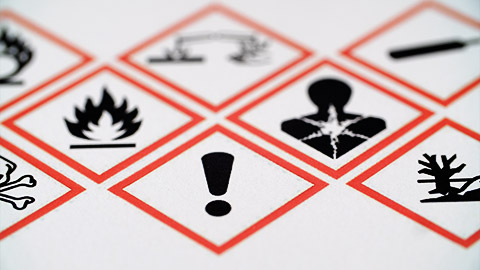
There are physical hazards that can present themselves within the animal care industry that you must be mindful of, which can help you take extra precautions.
The following table illustrates the common physical hazards that may be present in the animal care environment along with a preventative and suggested PPE to minimise the risk.
| Physical Hazard | Cause of hazard | Possible injury illness | Preventative/ PPE |
|---|---|---|---|
| Noise |
|
Sensitivity in ears, possible tinnitus for over-noise exposure Headaches Hearing loss over time |
Consider wearing earplugs or earmuffs. Keep doors between kennels/aviaries and other work areas closed. |
| Vibration | Certain hand tools, such as clippers | It may cause carpal tunnel syndrome if used excessively | Use personal protective equipment and take regular breaks to reduce this risk |
| Electrical |
|
Electrocution | Electrical faults need to be reported and repaired by a licensed electrician. Equipment that has been checked needs to be tagged and tested by law. |
| Security | Violent or aggressive encounters with people | Physical violence |
|
| Slips, Trips and Falls |
|
|
|
| Heat |
|
|
|
| Ocular (eyes) |
|
Long-term eye damage |
|
| Gravity |
|
|
|
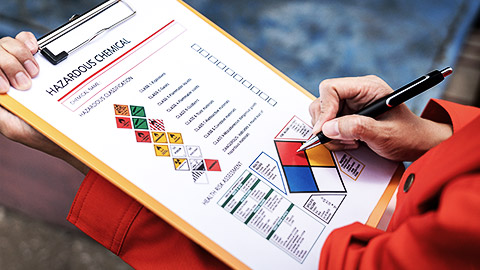
Hazardous substances that have the potential to cause harm to the body and may also endanger the environment if not disposed of correctly can be found in the workplace in several physical forms, such as:
- fumes
- smoke
- mist
- gases
- vapours
- liquids.
The following table illustrates the chemical hazard categories and the damage that can be inflicted with exposure.
| Chemical hazard category | Consequences of exposure |
|---|---|
| Toxic and/or corrosive/irritant chemicals | It may cause damage to the environment and also human skin (if in contact) or body (if ingested/inhaled). For example, undiluted disinfectants or euthanasia drugs containing anaesthetic (Lethabarb and Euthal). |
| Carcinogens | It may cause cancer if prolonged, unprotected exposure is allowed. For example, tissue specimen fixatives like Formalin. |
| Medications |
Controlled drugs have a high risk of abuse or addiction. For example, analgesics (painkillers) and Methadone. Some medications may be absorbed into the skin if PPE is not worn. |
| Flammables / Explosives | It can immediately injure people and animals and also damage property if uncontrollably released and/or ignited. Examples include liquid petroleum gas (LPG), gasoline (Petrol), and oxygen. |
Ensure you are aware of the risks associated with the chemicals you use in your workplace. Supervisors and Safety Data Sheets should be consulted as necessary, particularly with the arrival of new chemicals. Personal protective equipment MUST be used if a supervisor recommends it, as well as policy/procedure and/or safety data sheets.
Hazardous substances may enter the body in the following ways:
- Ingestion - Eating or drinking the substance.
- Inhalation – Breathing in fumes, vapours, mists and dust.
- Absorption - Chemical contact with mucous membranes, eyes, and skin.
- Parenteral - Administration by injection, either accidental or intentional.
People will be affected by contact with hazardous substances to a greater or lesser degree depending on the toxicity of the substance, amount of substance taken into the body, duration of exposure to the substance and individual biological and physiological differences (for example, age, weight, metabolism, immune function and pregnancy).
Safety Data Sheets
Documents that provide critical information about hazardous chemicals are known as Safety Data Sheets (SDS); they may also be referred to by their previous name, Material Safety Data Sheets (MSDS).
In Australia, manufacturers and importers of hazardous chemicals must prepare an SDS for each product and make this readily available. Workplaces must keep copies of relevant SDSs in a readily accessible location for all employees who may require them. Your workplace will potentially have these in a manual or computer system. Note: SDSs are regularly updated, and workplaces must check for any updates routinely and download/print out the correct version for their manual.
These documents include:
- the chemical's identity and ingredients
- health and physical hazards
- safe handling and storage procedures
- emergency procedures
- disposal considerations.
Review this sample of a Sample Safety Data Sheet (pdf).
Source: 2022. [online] Available at: <https://www.osha.gov/sites/default/files/2020-04/Sample%20SDS%20Handout.pdf> [Accessed 26 May 2022].
Safe Storage and Handling
Hazardous substances must be stored securely and labelled clearly. A number of the substances used in veterinary practice must be kept in locked storage and accessed only by veterinary practitioners. They may include medications and dangerous drugs.
Your clinic will have policies and procedures related to the storage and handling of dangerous chemicals and drugs, and you should ensure you know what these are and the level of responsibility you have for handling them. Some chemicals that you are likely to come into contact with in animal care include:
- sterilising chemicals, including disinfectants
- cleaning products, including detergents
- solvents.

Inevitably, hazards do arise in the workplace environment. The use of equipment and machinery is a high consideration. Some examples (but are not limited to) include:
| Machinery | Equipment |
|---|---|
| X-ray machine | Surgical equipment |
| Moving parts from machinery | Needles |
| Anaesthesia machine | Microscopes |
| Suction machines | Catheters |
Controllers of the equipment, machinery appliances or substances used in the workplace also have legal responsibilities. Plant controllers may include specialist contractors handling the installation or decommissioning of equipment in the workplace. The Regulation stipulates the risk management requirements with which the contractor must comply.
Any equipment that may affect the health and safety of the public is also the responsibility of the plant owner, as stipulated by legislation.
Essentially, any other personnel required in the work environment has a responsibility to take reasonable care of their health and safety and all other personnel in the workplace. To achieve this, they must comply with any reasonable instruction given by the employer/PCBU and ensure that their actions or omissions do not adversely affect the health and safety of any personnel in the workplace.

UV Radiation
Otherwise known as sunburn. It may cause skin cancer.
Prevention methods for sunburn include covering all exposed areas of the body by wearing:
- long sleeve shirts and full-length pants to cover all exposed areas of the body
- a wide-brimmed hat
- sunscreen with a sun protector factor of SPF30+
- UV protective sunglasses.
Please note: Glass, windows and clouds do not protect you from UV radiation, you can still get burnt on overcast days.
X-Rays
Only appropriately trained and qualified staff with a current radiography licence should operate the machinery (in most cases, this is only veterinarians), and they have specific instructions to follow and must wear personal protective equipment.
Repeated exposure of human tissues to invisible X-rays may cause:
- tumour development
- cataracts
- foetal damage
- bone marrow damage
- cutaneous burns
- blindness
- infertility.
Be aware of this hazard, however, as you will not be required to operate this type of equipment it is a very low risk to you. If you are asked to assist the veterinarian, follow WHS procedures and policies. You need to ensure you are wearing the correct PPE.

Clinical waste is the by-products of medical, nursing, dental, veterinary, pharmaceutical or similar professions and may consist of human or animal tissue, blood, body fluids, excretion, drugs, swabs, dressings, syringes, needles and other sharp instruments.
These products may pose a hazard to people encountering them due to the risk of physical injury (cutting oneself with a sharp implement) or infection (from contaminated sources).
Storage, treatment and disposal
Producers of clinical waste should ensure that such waste is stored, treated, and disposed of in the following conditions:
- Stored in a leak-proof container with a securely fitting lid.
- Stored in a weatherproof, secure location.
- Isolated from other wastes.
- Stored in a manner that poses no threat to health, safety or the environment.
- Clearly labelled as containing clinical or biological/ biohazard waste.
- In the case of accidental spillage, all necessary equipment to clean and disinfect the area should be readily available. This may include a spill kit.
- Disposed of as soon as reasonably possible as per legislative or regulatory guidelines. For example, specifically licensed contractors may be required to pick up clinic waste, or local government (councils) may have stipulations regarding the disposal of animal waste and carcasses.
- If any other waste is mixed with clinical waste, that waste is also to be treated as clinical waste.
The following symbol warns of a potential biological hazard associated with clinical waste. This symbol/warning sign might be displayed on disposal receptacles like sharps containers or certain bins.
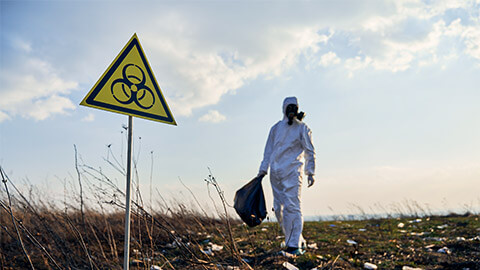
Sharps
Sharps are objects or devices with sharp points capable of cutting or piercing the skin, causing needle stick injuries and infection. This includes but is not limited to, hypodermic needles, scalpels, syringes, broken glass ampoules and/or bottles and scissors.
Sharps must be disposed of in special containers that are secure and appropriately labelled; they are then collected by or sent to licensed collection agencies for appropriate disposal. Sharps containers are variably sized yellow plastic containers that are:
- puncture-resistant, leak-proof, shatter-proof and able to withstand heavy handling
- clearly labelled as clinical waste and display the biohazard symbol
- It can be sealed when ready for disposal and is capable of being handled without danger of the contents spilling.
The following images are examples of sharps containers that are commonly used.
Assessing risk means determining the likelihood of the risk occurring and if it does what the severity level may be. The risk matrix below provides a visual reference of how risk likelihood and severity interact.
A determination of the likelihood of a hazard occurring is made and then a determination of the accompanying risk factor is also made. The two items will intersect within the matrix and depending on the colour code of the intersecting square the hazard is determined to be either High Risk (Red), Medium Risk (Orange), or Low Risk (Yellow). Hazards are ranked using this matrix in their initial instance however the risk factor can be reduced if control measures are utilised.
For example, the hazard of being bitten by a dog may initially be a Remote likelihood with a Major severity factor. However, the risk factor can be lowered to Extremely Remote likelihood if proper training is initiated for animal handlers and the severity factor can be reduced to Minor if personal protective equipment is utilised.
Watch
Watch the next video to help explain the Risk Matrix.
Next, read the below case study from Happy Paws Animal Care facility explaining the accessing risk process.
Case Study

Background
Happy Paws Animal Shelter is dedicated to rescuing and caring for stray and abandoned animals. Regular risk assessments are conducted to identify potential hazards and implement preventive measures to maintain a safe environment. This case study explores the process and outcomes of a recent comprehensive risk assessment at the facility.
Risk Assessment Process
Objective: Identify, evaluate, and mitigate potential risks to ensure the safety of staff, volunteers, and animals.
Steps Involved:
- Planning and Preparation:
- Assemble a risk assessment team, including managers, veterinarians, and experienced animal attendants.
- Review past incident reports, current protocols, and safety guidelines.
- Hazard Identification:
- Walkthroughs of the facility will be conducted to observe daily operations.
- Interview staff to gather insights on potential hazards they encounter.
- Analyze areas where previous incidents have occurred.
- Risk Evaluation:
- Assess the likelihood and severity of identified hazards.
- Prioritize risks based on their potential impact.
- Control Measures:
- Develop and implement strategies to mitigate identified risks.
- Update safety protocols and training programs.
- Ensure all control measures comply with relevant health and safety regulations.
- Monitoring and Review:
- Regularly review and update the risk assessment to address new hazards and changes in operations.
- Conduct follow-up assessments to ensure the effectiveness of control measures.
Identified Risks and Mitigation Strategies
- Animal Handling Risks
Hazard: Injuries from bites, scratches, and aggressive behaviour.
Assessment:
- Likelihood: High (due to the nature of working with stressed and unfamiliar animals)
- Severity: Moderate to high (potential for serious injury)
Control Measures:
- Provide comprehensive training on safe animal handling techniques.
- Use appropriate personal protective equipment (PPE) such as gloves and bite-resistant clothing.
- Implement behavioural assessment protocols for new animals to identify and manage aggressive tendencies.
- Establish clear protocols for handling aggressive animals, including isolation and specialized staff training.
- Ask for assistance
-
Chemical Hazards
Hazard: Exposure to cleaning agents and disinfectants.
Assessment:
- Likelihood: Moderate (regular use of chemicals for sanitation)
- Severity: Moderate to high (potential for respiratory issues, skin irritation, and chemical burns)
Control Measures:
- Store chemicals in clearly labelled, secure containers.
- Provide training on properly using and handling chemicals, including what to do in case of spills or exposure. All staff to be familiar with the Safety Data Sheet.
- Ensure adequate ventilation in areas where chemicals are used.
- Supply and enforce the use of PPE such as gloves and masks.
-
Slips, Trips, and Falls
Hazard: Wet floors, cluttered walkways, and uneven surfaces.
Assessment:
- Likelihood: Moderate to high (due to cleaning activities and high traffic)
- Severity: Low to moderate (potential for sprains and minor injuries)
Control Measures:
- Implement strict housekeeping protocols to ensure spills are promptly cleaned and floors are kept dry.
- Use non-slip mats and footwear.
- Place clear signage in areas where floors may be wet.- Wet Floor Sign.
- Regular maintenance is conducted to repair uneven surfaces and clear cluttered walkways.
-
Zoonotic Diseases
Hazard: Transmission of diseases from animals to humans.
Assessment:
- Likelihood: Moderate (due to the presence of sick or unvaccinated animals)
- Severity: High (potential for serious illness)
Control Measures:
- Enforce strict hygiene practices, including regular handwashing and hand sanitisers.
- Ensure all animals are vaccinated and regularly checked for diseases.
- Quarantine new or sick animals to prevent the spread of infections.
- Provide staff with training on recognizing symptoms of zoonotic diseases and proper handling procedures.
- Wear appropriate PPE.
Outcomes
Following the risk assessment, Happy Paws Animal Shelter implemented several key changes:
- Training: Enhanced training programs for all staff and volunteers, focusing on identified risks and safety protocols.
- Equipment: Investment in additional PPE and safety equipment.
- Protocols: Updated and more detailed safety protocols for animal handling, chemical use, and sanitation.
- Monitoring: Regular safety audits and ongoing risk assessments are conducted to ensure control measures' effectiveness and adapt to new risks.
Conclusion
The comprehensive risk assessment at Happy Paws Animal Shelter underscored the importance of proactive risk management in maintaining a safe environment for staff, volunteers, and animals. By systematically identifying and addressing potential hazards, the facility has significantly reduced the likelihood and impact of accidents and injuries, ensuring a safer and more efficient operation. Regular reviews and updates to the risk assessment process will continue to enhance safety and well-being at the shelter.
The next step is to follow the Hierarchy of Controls to select the best method of eliminating or reducing risk. One or more of these control measures should be applied to each hazard to reduce the likelihood and/or severity of an injury occurring.
The Hierarchy of Controls:
- Elimination
- Substitution
- Engineering Controls
- Administrative Controls
- PPE

When you arrive at your clinic, you must have knowledge of the roles and responsibilities of WHS representatives and WHS committees, as well as the managers and staff and how they are applied to the clinic.
WHS Committee and Officers, as well as staff, have a responsibility in their areas of control, and they include:
- Communicating to all employees the requirement to report hazards and incidents to the designated personnel
- reporting all workplace hazards, incidents and near misses before the shift ends or within 24 hours in a register as per the clinic reporting policies and procedures
- participating in the incident investigation process in consultation with the clinic's manager and/or senior duty vet
- initiating an incident investigation using the Incident Investigation Template as required
- complying with the requirements for reporting notifiable incidents to WorkSafe
- reporting serious incidents to WorkSafe or the relevant authority
- following safe work procedures and instructions
- updating the WHS Risk Register to reflect changes to hazards, risk ratings and controls. When all these people/areas work together about WHS, then the following can be achieved.
Productive Workplaces:
- Improvements in WHS performance and overall business performance and productivity.
Safe Workplaces:
- A reduction in the incidence, severity, and costs (both direct and indirect) of workplace injury and disease.
Supportive Workplace Culture:
- Improvements in communication and consultation between management and employees, as well as support for a positive health and safety culture, are needed.
Compliant workplaces:
- Ensures that the agency can achieve its legal obligations under the WHS Act
Report incidents and injuries to the supervisor
Whenever you are conducting work at your clinic and you sustain an injury or you observe a near miss (see below for definition) then they must be reported to the designated person, this could be the owner of the practice, business manager or if your clinic has aHealth and Safety Officer.
When identifying a hazard, you must complete an incident/*near miss reporting form and report it to the appropriate person.
- The employee is to complete all required fields on the form.
- Once the incident/*near miss report is completed, the clinic’s Manager and/or senior duty vet will need to receive a copy.
- This report must then be actioned per the clinic's policies and procedures.
* A near miss is defined as any occurrence that might have led to an injury or illness to people, danger to health and/or damage to property or the environment.
Conducting a risk management review must be done in the following circumstances:
- A significant change occurs in the workplace. For example, the initial set-up of the business, the purchase of new equipment, or the hiring of new staff.
- Evidence shows that a risk control measure does not adequately control the risk. For example, the number of incidents and/or their severity has not noticeably or statistically decreased since the initial control measures were implemented.
- A notifiable incident occurs. For example, the death of a person, a serious injury/illness, or a dangerous incident that may have exposed people to risk (near-miss).
Set up an appropriate review timeframe whenever undertaking the risk management process and ensure it is documented in the applicable policy/procedures.
Read the following scenarios and reflect on best practices:
(Think: Think about some of the risks you may encounter and what you can do to minimise the risks or stop them)
Scenario 1: Handling an aggressive dog in a shelter
At Happy Paws Animal Care, every day brought new challenges, but none as daunting as the arrival of Max, a large, muscular German Shepherd mix. His previous owner had surrendered Max due to his increasingly aggressive behaviour. The staff knew this wouldn’t be easy, but they were committed to giving Max a second chance.
Max’s first day at the shelter was tense. He growled and barked at anyone who approached his kennel, his eyes filled with fear and distrust. His history was unclear, but it was evident that Max had been through a lot. The shelter’s manager, Sarah, decided to take the lead in working with him. Sarah was experienced and deeply understood dogs, especially those with behavioural issues.
What are some risks you may encounter?
- Bites
- Scratches
- Injuries from being knocked over
- Stress or anxiety
Control measures to minimise the risk?
- Training: Ensure staff are trained in animal handling techniques, especially for aggressive animals.
- Use of Restraints: Utilize appropriate restraints like muzzles, leads, or crates to safely control the dog.
- PPE (Personal Protective Equipment): Wear protective clothing such as gloves and long sleeves.
- Calming Techniques: Use calming signals and soft voices, and avoid direct eye contact to reduce the dog's stress.
Scenario 2: Administering Medication to a Fractious Cat
At Happy Paws Animal Care, every animal had its unique quirks, but none were quite as challenging as Shadow, a sleek, black cat with piercing green eyes. Shadow had been a resident of the shelter for a few months, and while he was generally quiet, he had a reputation for being uncooperative, especially when it came to handling. This morning, Shadow’s health took a concerning turn; he developed a respiratory infection that required immediate medication.
Sarah, one of the experienced staff members, was assigned to administer Shadow's medication. She knew this wouldn’t be an easy task. Shadow had always been wary of humans, and his fractious nature made him particularly difficult to handle. But Sarah was determined to help him feel better.
What are some risks you may encounter?
- Bites or scratches from the cat.
- Stress-induced aggression leads to injury.
- Inaccurate medication dosage due to resistance or movement.
Control measures to minimise the risk?
- Restraint Devices: Use cat bags, towels, or gloves to safely restrain the cat.
- Two-Person Technique: Have a second person assist to hold the cat securely.
- Calm Environment: Administer medication in a quiet, calm environment to reduce the cat's anxiety.
- Proper Training: Ensure staff are trained in safe medication administration techniques.
Scenario 3: Cleaning out Reptile Enclosure
It was an unusually quiet morning at Happy Paws Animal Care, and Sarah, the dedicated staff member, was ready to tackle her next task: cleaning out the reptile enclosure. The reptile room housed several fascinating creatures, but the most imposing of all was Rex, a six-foot-long, emerald-green iguana with a personality as big as his size. Rex was a striking creature, but his enclosure needed regular cleaning to keep him healthy and happy.
Sarah knew that cleaning Rex’s enclosure required both care and caution. Reptiles, especially large ones like Rex, could be unpredictable, and she needed to be mindful of potential risks, such as bites, scratches, or even the transmission of zoonotic diseases like salmonella.
What are some risks you may encounter?
- Exposure to zoonotic diseases such as salmonella.
- Bites from reptiles, especially venomous species.
- Inhalation of dust or fumes from bedding or cleaning agents.
Control measures to minimise the risk?
- PPE: Wear gloves, masks, and eye protection to prevent exposure to pathogens and chemicals.
- Training: Ensure staff are trained in the safe handling of reptiles, especially venomous species.
- Safe Cleaning Products: Use non-toxic, reptile-safe cleaning products.
- Proper Ventilation: Ensure the area is well-ventilated during cleaning to avoid inhaling harmful substances.
